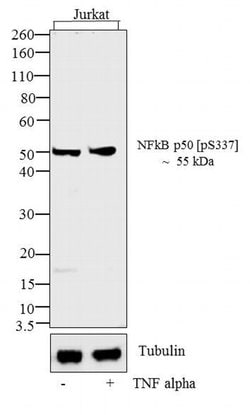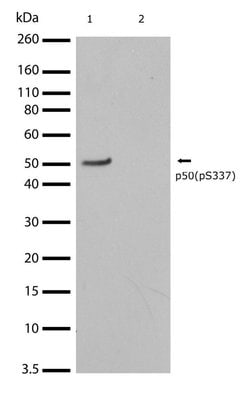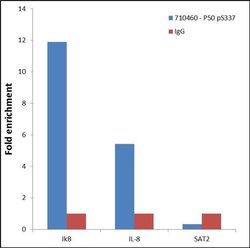Learn More
Invitrogen™ Phospho-NFkB p50 (Ser337) Recombinant Superclonal™ Antibody (2HCLC)
Rabbit Recombinant Superclonal Antibody
Supplier: Invitrogen™ 710460
Description
Recombinant rabbit Superclonal™ antibodies are unique offerings from Thermo Fisher Scientific. They are comprised of a selection of multiple different recombinant monoclonal antibodies, providing the best of both worlds - the sensitivity of polyclonal antibodies with the specificity of monoclonal antibodies - all delivered with the consistency only found in a recombinant antibody. While functionally the same as a polyclonal antibody - recognizing multiple epitope sites on the target and producing higher detection sensitivity for low abundance targets - a recombinant rabbit Superclonal™ antibody has a known mixture of light and heavy chains. The exact population can be produced in every lot, circumventing the biological variability typically associated with polyclonal antibody production. Note: Formerly called Recombinant polyclonal antibody, this product is now rebranded as Recombinant Superclonal™ antibody. The physical product and the performance remain unchanged.
NFkB is a nuclear transcription factor activated by various extra and intracellular stimuli such as cytokines, UV radiation, stress, in injury, and by bacterial and viral products. NFkB is involved in regulation of various cellular events including cell growth, differentiation, proliferation, apoptosis and inflammation. NFKB1 (p50) is a 50KDa functional sub-unit of NF-kB and a member of Rel protein family which is synthesized as a p105 precursor protein and consists of an N-terminal conserved RHD-region containing nuclear localization signal, DNA-binding and dimerization domains. NFKB1 (p50) forms homodimers or heterodimerizes with p65, forming the functional NFkB factor. Further, NFKB1 (p50) directs the nuclear translocation of NF-kB and is instrumental in its DNA-binding. The NFkB complex is expressed in most cell types, and is primarily found in the cytoplasm in an inactive state in association with I-kappa-B. Phosphorylation of I-kappa-B releases the complex, allowing translocation to the nucleus and modification of gene expression. Phosphorylation of the p50 subunit at the Ser-337 residue has been shown to significantly increase DNA binding efficiency of the NFkB protein complex. The pathological role of NFkB has been suggested in AIDS, hematogenic cancer cell metastasis and rheumatoid arthritis.
Specifications
| Phospho-NFkB p50 (Ser337) | |
| Recombinant Superclonal | |
| 0.5 mg/mL | |
| PBS with 0.09% sodium azide | |
| P19838 | |
| NFKB1 | |
| Peptide corresponding to amino acids 333-341 of human p50 [pS337]. | |
| 100 μg | |
| Primary | |
| Human | |
| Antibody | |
| IgG |
| ChIP Assay, ELISA, Western Blot | |
| 2HCLC | |
| Unconjugated | |
| NFKB1 | |
| CVID12; DKFZp686C01211; DNA-binding factor KBF1; EBP-1; KBF1; MGC54151; NF kappaB1; NF KB; NFkappaB; NF-kappaB; NF-kappa-B; NF-kappaB p50; NF-kappaB1; NF-kappa-B1 p84/NF-kappa-B1 p98; NF-kappabeta; NF-kB; NF-kB p50; NFKB1; NF-kB1; NFKB-p105; NFKB-p50; nuclear factor; nuclear factor kappa b; nuclear factor kappa B subunit 1; nuclear factor kappa-B 1; nuclear factor kappa-B DNA binding subunit; nuclear factor kappaB p50; nuclear factor NF-kappa-B p105 subunit; nuclear factor NF-kappa-B p105 subunit-like protein; nuclear factor NF-kappa-B p50 subunit; nuclear factor of kappa light chain gene enhancer in B-cells 1, p105; nuclear factor of kappa light polypeptide enhancer in B-cells 1; nuclear factor of kappa light polypeptide gene enhancer in B cells 1, p105; nuclear factor of kappa light polypeptide gene enhancer in B-cells 1; nuclear factor of kappa light polypeptide gene enhancer in B-cells 1 (p105); nuclear factor of kappa light polypeptide gene enhancer in B-cells 1, p105; nuclear factor-kappaB p50; OTTHUMP00000219572; p105; p50; p50 subunit of NF kappaB; p50 subunit of NF-kappaB; p50/p105; RHD of nuclear factor NF-kappa-B p105 subunit | |
| Rabbit | |
| Protein A | |
| RUO | |
| 4790 | |
| Store at 4°C short term. For long term storage, store at -20°C, avoiding freeze/thaw cycles. | |
| Liquid |
Safety and Handling
Your input is important to us. Please complete this form to provide feedback related to the content on this product.


